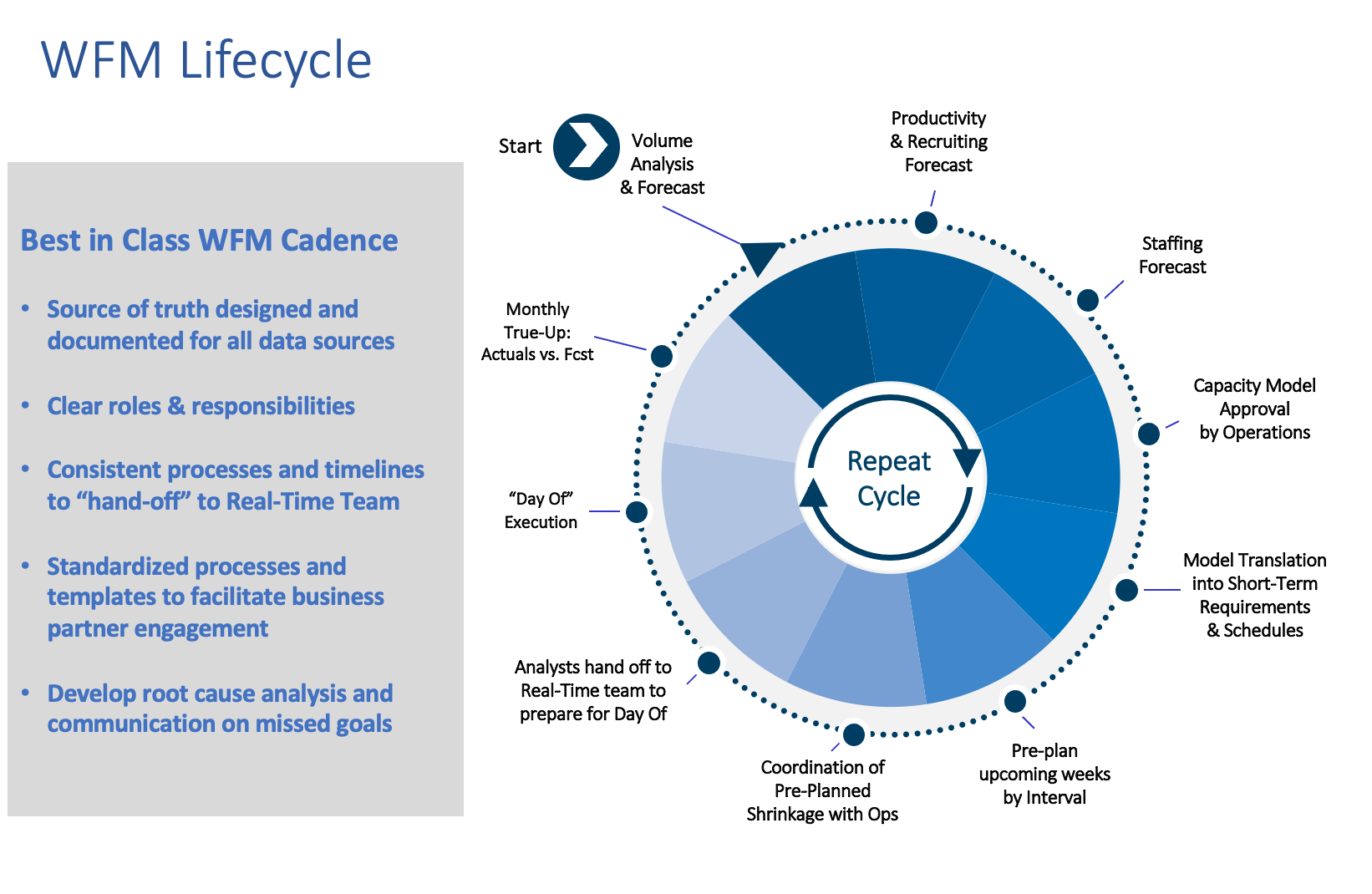Ensuring scheduling efficiencies while carefully considering the needs of associates is a difficult balancing act even for a sophisticated Workforce Management team. However, when executed correctly, effective workforce staffing practices can have a long-term impact on a company’s competitiveness and sustainability.
Capacity planning models are used to convert forecasts for volume, Average Handle Time (AHT), and shrinkage into the required number of full-time equivalents (FTE’s) needed to handle a contact center’s workload, allowing managers to project staffing excesses and deficits. Managers can proactively plan to ensure the right number of people are available at all times by joining existing workforce management functions— such as short-term forecasting, scheduling, and real-time management — to a well-grounded capacity planning model. The resources and continual cadence that a Workforce Management Department puts forth as an investment in building out this process, will pay off in upcoming years.
The following are best practices for assessing and improving a company’s workforce management capacity plan:
1. Reforecast Monthly
The WFM capacity plan should be refreshed monthly to provide a realistic view of FTEs required and the timing of new hires for the upcoming year. This monthly cadence allows you to identify trends quickly and consistently and proactively adjust your hiring plan to reflect current insights, while developing an operational game plan to minimize risks.
The first step is updating the previous month’s actuals to enable an analysis of current trends, actual results and forecast variances. You should compare actuals to your previous forecast, and trends to year-to-date, year over year and your annual budget, all of which can provide insights on risks and/or favorable trends you should consider in your next monthly forecast.
The following example highlights why this is important to your contact centers’ performance and financial results: You forecasted “x%” attrition and a contact rate of “y”. Both were favorable during the last few months, so you decide the trend warrants reforecasting.
- You could potentially delay hiring a class by a month or two which can result in a savings of $60-$70k per month.
- Alternatively, you could determine that instead of a new hire class of 18, you only need a class of 15, which would also result in significant savings.
A monthly reforecasting cadence allows you to “course correct” and strengthen your overall forecast, transitioning your organization to a proactive planning cycle vs. reactive adjustments. Implementing this best practice also allows organizations that utilize outsourcers to lock in a 90-day forecast with the accuracy that most suppliers require.
2. Forecast Realistically
As you develop your forecast, make sure you are projecting hiring needs based on current trends and planned initiatives. Far too often, organizations forecast with a presumed FTE objective in mind and/or forecast to a desired productivity goal, even though current trends don’t support these assumptions. You can avoid the pain of having to use additional resources to solve an understaffed situation by forecasting realistically and following up with a proactive action plan to reach desired goals, budgets, or metrics. If this best practice is not followed, you risk understaffing or overstaffing your organization for a prolonged period; it’s always less efficient to dig out of a staffing shortage as all the metrics go the wrong way in a prolonged staffing deficit.

3. Account for Attrition
In addition to proactively determining the number of people you need to hire, your capacity planning model should factor in the impact of attrition. Attrition should be tracked monthly and utilized to develop trends to enable proactive hiring of employees prior to the attrition; this ensures you have employees staffed and trained as the attrition occurs instead of reacting to the attrition afterwards and starting the recruiting / training process. Secondly, it’s important to account for new hire attrition trends. Accounting for new hire attrition is essential to ensure that the right number of new hires are fully onboarded. Far too many organizations forget this component and end up understaffed — this outcome has a direct impact on financial forecasting and planning. As you evaluate trends, you will notice a consistent pattern in the percentage of staff that completes the new hire training process. Once you establish these trends, you can ramp up your hiring goal to consider new hire attrition and to ensure you have the right number of people completing training at the right time.
4. Collaborate
The best monthly forecasts include both an upfront analysis from Workforce Management and a collaborative discussion with Operations that considers trends and operational insights. Operations leaders are critical partners in this process, so it is important to share insights with them regarding any changes in trends, action plans, or initiatives that are expected to have an impact on ongoing forecasts. From capacity planning to budgeting, Workforce Management and Finance cannot execute a monthly refresh in a vacuum — Workforce Management, Finance, and Operations must work collectively.
The value of Workforce Management lies in the process and making sure the right due diligence and analysis are carried out. Successful organizations make improvements sooner rather than later and most organizations can strengthen their results by getting into a solid cadence of conducting monthly reforecasts. Although there are many challenges to consider, staffing for success can best be accomplished with a capacity planning model that allows for proactive and accurate forecasting of staffing needs. Contact us to learn more about The Northridge Group’s Workforce Management solutions.

Featured Case Study





Capacity planning is a major part where you can see better forecasting and prepare yourself for good plan. It is a informative article.